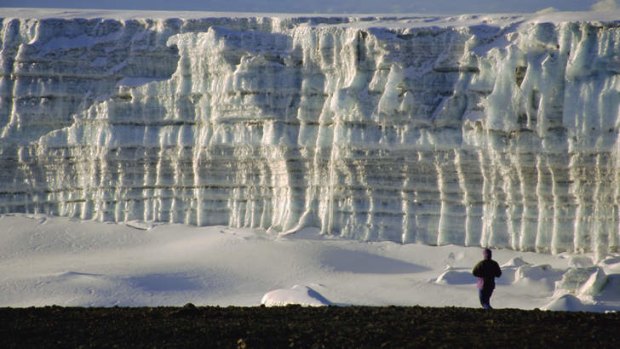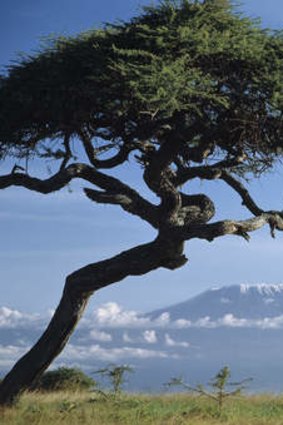
Glaciers at Uhuru Peak.
Peter Cochrane sings Kilimanjaro's praises and warns about its receding ice cap on a trek to the summit.
Towering over the Tanzanian plain, Mount Kilimanjaro stands alone, a fabled thing, a vision that for centuries has fed the imagination of locals, slave-traders, missionaries, and miscellaneous explorers, to say nothing of writers and filmmakers in more recent times. The enchantment surely resides in the paradox: a snowcapped mountain just a few degrees south of the equator and smack-bang in the middle of safari country; a massif so vast as to create its own weather patterns, and so high you must climb through four ecozones to reach the summit, 5895 metres above sea level.
The summit is our objective, but we are in no hurry. Oxygen is scarce on the upper reaches of the mountain. Our bodies will need time to adjust to avoid altitude sickness. My group of seven sensible lowlanders is taking the Shira Route, a six-day trek angling across the southern side of the mountain. This way we can savour the journey as much as the destination, trekking through some of the most dramatic changes in landscape you can imagine.

Giddy heights...snowcapped Kilimanjaro rises incongruously above sun-drenched plains.Credit: Corbis
To begin, we cheat a little by driving up the foothills past crops of beans and maize, banana farms and coffee plantations, every ridge and furrow a reminder of how much the local people, the Chagga, rely for survival on the fertility of mountain soil and a multitude of streams that flow down from the glaciers at the top. Despite the dramatic retreat of the ice cap in recent times, Kilimanjaro is still a fount of life. To grasp the reach of Kili's impact on the region, consider this: at its base, the mountain covers almost 5000 square kilometres- twice the size of Luxembourg.
The Shira Plateau (3350 metres) is one of Kili's most intriguing landscapes. Shira was the first volcano here, collapsing and choking to extinction on lava from adjacent eruptions about 750,000 years ago. Its glory days are marked by the jagged, olivine spires of the crater wall to the south, crusty battlements briefly bathed in sunshine. We are walking on the solidified throat of the old crater, a vast amphitheatre of volcanic rock, the heath and everlastings growing here enriched by the dung of jackals and wild buffalo.
My handbook states that lions occasionally roam on the plateau, as do grey and red duikers, elands and bushbucks, but that "sightings are extremely rare". Like the leopard supposedly found frozen in snow near the summit - which in turn inspired author Ernest Hemingway's famous short story The Snows of Kilimanjaro - I suspect this lion talk is the stuff of legend.
We trek east across the plateau until we reach the slopes of Kibo, the youngest and highest of the surviving craters on Kilimanjaro. Photographs of Kibo are iconic images, showing the volcano sitting heavy on the landscape like some sleeping mammoth, or surfacing from the mist like a whale, the shoulders mantled in snow and heavy brow shrouded in thick, white cloud.
In the days that follow, we ascend Kibo by degrees towards the mountain's alpine desert zone, climbing high in the afternoons and dropping down a little to eat and sleep. From our campsite we see Mount Meru in the distance, appearing to float on a bed of pure white cloud. We lunch and head out on a punishing afternoon climb, steeper by the hour, to the summit of the oddly named Lent Hills, 4700 metres above sea level. Hills indeed. These are sheer and spectacular volcanic outcrops - think Monument Valley; think Mars with attitude.
On our third climbing day we traverse lava ridges beneath glistening white glaciers in sight of the notorious "death zone" on the Western Breach, now closed to trekkers; lunch at our Lava Tower campsite (4550 metres), a promontory above the clouds; and commit the afternoon to a spectacular walk on the slopes fringing the Breach. We are heading for the ruins of an old hut at Arrow Glacier (4800 metres). This is getting into serious altitude territory for lowlanders such as myself. The drop down to our campsite helps, our blood working overtime to catch up with the atmospheric conditions. The at-altitude symptoms are shared around - headaches, exhaustion, a little giddiness.
On day four we descend to the floor of the Barranco Valley (3900 metres), an oasis of green cosseted by towering cliffs - the work of avalanches - and criss-crossed by glacial streams. Here, topography and botany have conspired to quirky purpose. The valley is host to weirdly phallic lobelias and Senecio kilimanjari, the tree groundsels that dominate the terrain. Some stand five metres high, thickset, woody and petalled with layers of downy bark, the stumpy branches topped with green rosettes, like giant candelabra from another world. The senecios are oddities much favoured by the most dazzling creature on the mountain, the iridescent green and black malachite sunbird, which seems to be thriving.
We cross the valley. The way out is pretty much straight up the Barranco Wall, 330 metres to the top. If you like scrambling up near-to-sheer rock faces, this wall is for you. The top is a ridge that leads to an undulating trail around the south-eastern flank of Kibo, volcanic scree underfoot, thick clusters of white everlastings in the sheltered hollows.
We take a rest while our porters pass by with hefty loads balanced on their heads. They, too, have climbed the wall; how, we cannot imagine. They are young, fit and eager for the income that goes with the job. They will forge ahead, set up tents and have the camp kitchen humming before we arrive for lunch. Their work puts our efforts into perspective and we feel humbled. There is something uncomfortably colonial about the set-up and yet, in post-colonial Tanzania, tourism is vital to the economy and portage is a way out of a meagre subsistence on the baking, drought- ridden plains below.
Beyond the wall, the terrain becomes more severe, the mountain skirted by deep-cut valleys that carry glacial streams to the lowlands. The views of the southern ice fields are a magnificent diversion during the climb. "Pole-pole," (slowly, slowly) our guide says. Apart from "jambo", this may be the most repeated Swahili expression on the mountain.
Next day we press on to our final camp before the summit, making a steep, four-hour climb from the Karanga Valley to the Barafu campsite. The temperature is below freezing and brilliant white tongues of ice reflect most of the heat of the equatorial sun. Thus the glaciers persist, but in ever-diminishing scale, fortified by cold snaps that have recurred down the centuries, leaving us to ponder the monumental quality of what we see - glacial moraines, retreating cover, dazzling white spikes and spires, and the columns and pillars of ice that mark the Arctic zone.
Across the millennia, there have been times when the snow cover pressed as far down as the treeline in sight of the rainforest, and other times when there was no snow at all. Some scientists say the glaciers will be gone in a matter of decades; others disagree. What is clear is the current trend line - Kilimanjaro's famous white mantle has shrunk 82 per cent since the first known survey was undertaken in 1912. The survival of the diminishing snow cover is a matter of great concern for Tanzania's economy, for water supply in the region, agriculture and, of course, tourism. A lot of life depends upon the snows of Kilimanjaro.
At midnight we leave for the 1300-metre climb to the summit, hoping to be at the crater rim when the sun rises over Mawenzi, sister to Kibo, the volcanic crater to the east - a jagged, sawtooth thing that looks like a fortress from The Lord of the Rings.
This is a steep, serpentine climb over loose volcanic scree, where the cold creeps into your body. The higher we go, the steeper the track. Our lungs and legs ache for more oxygen; every step is an effort and we slow to a crawl.
The peaks of Mawenzi are now behind and below us, set against the faintest glow of the coming sun. Pretty soon that pale, milky light is a rich orange band across the line of the horizon, the curvature of the Earth clearly visible. We are now among the spectacular glaciers and ice cliffs that still occupy much of the cap. The six-day journey has allowed us to see many faces of Kilimanjaro, but nothing quite matches the moment when we arrive at Uhuru (Freedom) Peak, the mountain's summit. The sun is up, clouds have cleared and far below, the vast African plain stretches to the bowed horizon.
FAST FACTS
Getting there Kenya Airways has a fare to Kilimanjaro for about $2670 low-season return from Sydney and Melbourne, including taxes. Fly to Bangkok (about 9hr with Qantas), then to Nairobi (9hr, 30min) and then to Kilimanjaro, Tanzania (70min). See kenya-airways.com.
Climbing there World Expeditions has a 10-day Kilimanjaro Shira Route package priced from $2990 a person, twin share. The price covers transport costs in the mountain region, park fees, accommodation in Arusha, all group camping and catering equipment on the Kilimanjaro climb (sleeping bags and mats are not provided), experienced mountain guides, cook and camp crew, porters and all meals on the trek. The climbing is spread across eight days to give maximum possible acclimatisation. Private group rates also available. See worldexpeditions.com.
When to go December to February and June to October are best. On lower slopes the weather is usually mild — warm days, cold nights. Be prepared for temperatures well below freezing at the summit.
Peter Cochrane travelled courtesy of World Expeditions.
Sign up for the Traveller Deals newsletter
Get exclusive travel deals delivered straight to your inbox. Sign up now.